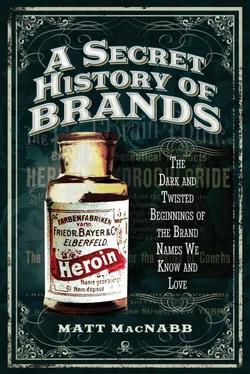Clark Stanley’s Snake Oil Liniment boasted quite a few more remedies, including general pain and lameness, rheumatism, neuralgia, sciatica, lame back, lumbago, contracted cords, toothache, strains, swellings, frost bites, chilblains, bruises, sore throat and even bites from animals, insects and reptiles! When the mixture was finally tested by the United States government in 1917, it was found to simply contain ingredients similar to a liniment or chest rub.
There became a need to regulate a great number of industries by the late nineteenth century, and one of those was the medicine trade. A good number of remedies may have had some slight means of medicinal assistance to them, but the reality is that a greater number were a complete sham and were sometimes more harmful than good. The regulation of drugs was so very dire not just because of the unregulated bitters, but due to the chemists offering what we still consider to be hard drugs today.
In Victorian Britain the attitude towards what we now consider to be illegal or subversive drugs was drastically different. The average chemist’s shop would offer a number of drugs, including opium and cocaine. The Industrial Revolution was a time of great change, but also a time of increased drug use, not only by the working classes, but also the artists and writers of the era. An opium or morphine addiction wasn’t as uncommon as it ought to have been.
It was near the latter half of the nineteenth century that a German chemist would create what he thought would be a cough remedy with pain relieving effects but without the addictive properties of morphine or codeine. It was through these noble intentions that one of the most terribly addictive drugs in the world today would be accidentally created.
The History of Bayer
The history of the company known as Bayer AG dates back to 1863, when the company was founded in Barmen, Germany. The first major mark that Bayer made on the world was when they copyrighted and sold aspirin, a product they are still known for today. The chemists at Bayer were hard at work developing their synthetically modified version of salicin, which they would eventually copyright as aspirin in 1897. Aspirin would enjoy a huge share of the marketplace, until two options with less side effects were introduced, acetaminophen in 1956 and ibuprofen in 1969.
There was controversy within Bayer early on, beginning with the true identity of the chemist who developed aspirin. The record books state that German Felix Hoffmann was responsible for the product, but those claims have been refuted by Arthur Eichengrun, a Jewish chemist who also worked for Bayer at the time. His claim is that once the company became entwined with the Nazi party during the Second World War, he was written out of the record books. The facts are that no documents prior to 1934 actually credit Hoffman with the invention. A company like Bayer, who had merged at the time with IG Farben, was very involved with the Nazi party in Germany, and therefore had every motivation to participate in an ‘Aryanisation’ of their history, especially when it comes to their most famous product. The idea that a Jewish chemist would be replaced in their records isn’t outside the realm of possibility.
Who created Heroin?
The creation of heroin was truly without any intended malice, even though the end result would come to be a blight on society that would be felt well over a century later. A chemist named C. R. Alder Wright was the first person responsible for synthesising diacetylmorphine, now commonly known as heroin back in 1874. The British chemist came upon the mixture while he was experimenting with combining morphine with various acids. His results were recorded, but nothing more came of it at the time. This wasn’t the point at which the world would be introduced to heroin.
The real introduction of the drug wouldn’t happen until twenty-three years later at a Bayer pharmaceuticals factory in Wuppertal, North-Western Germany. A Bayer chemist by the name of Felix Hoffmann, the same one that was credited with aspirin, was the man responsible for the drug. He was instructed by his supervisor, Heinrich Dreser, to produce a more effective substitute for codeine for the pharmaceutical company. There were issues with the addictive properties in codeine, so Bayer was looking for an all-new non-addictive alternative to introduce into the marketplace.
The result of Hoffman’s work would not, ironically, produce codeine, but rather a drug that is actually far less potent and more highly addictive than morphine, not to mention two and a half times more potent! The drug that would become known and marketed as heroin, was originally referred to as ‘Heroisch’, the German word for ‘Heroic’. The name was a reference to the elevated emotional state that Bayer discovered the drug induced in its user. The emergence of the formula by Hoffman would lead to Bayer pioneering the commercialisation of heroin around the world. The drug was marketed as a non-addictive medicinal alternative to morphine and codeine; a claim that we are now well aware was false.
The testing phase began immediately and was conducted mostly with rabbits and frogs, but soon moved to human trials. The drug was tested on various Bayer employees and even on Hoffman himself. The next stage involved Dreser presenting heroin to the Congress of German Naturalists and Physicians in November of 1898. Dreser touted the drug as a miracle cure for coughs that was ten times more effective than codeine, with ten times fewer side effects, and none of the habit-forming properties. Bayer trademarked its original ‘wonder drug’ in 1898 and would soon market it to families worldwide.
Dr Bernard Lazarus did his own analysis of heroin, which he published in the Boston Medical and Surgical Journal, in 1900. In this he cited seven cases in which the use of heroin hydrochloride for the relief of coughs, especially in the case of tuberculosis, was an effective option. He goes on to state: ‘The very thorough investigations which I have made with heroin hydrochloride in my practice enable me impartially to state that I consider this drug a most valuable aid to the medical profession.’
Why Heroin? The Purpose and Cures
In our age of modern medical achievements we may ask ourselves why would any parent turn to a dangerous drug like heroin as a cough remedy for their children? The reputation of heroin is well established today, but back in the late nineteenth century it was a brand-new product, without the horrific reputation it carries today. Bayer was simply filling the need that was left in the marketplace to address the mortal fear of the dreaded cough. When a child came down with a cough in this pre-vaccination era it was a frightening situation for their parents. There was an intense, but very well founded, fear of a deadly disease striking, such as tuberculosis, pneumonia or pertussis (aka whooping cough). The death toll from tuberculosis in the United States alone back in 1900 was nearly 150,000 per annum. The prevalent thought process at the time was that the intense cough was the symptom that would lead to the disease. We now know that is not the case, but the desire to prevent and eliminate a cough once it surfaced, and to eliminate coughing fits while one was trying to rest, was one that companies were happy to try and satisfy through various remedies and products.
Heroin Marketed to Children
It was all the way back on 6 March 1899 when Bayer first patented aspirin (acetylsalicylic acid) with the Imperial Patent Office in Berlin, but for decades now, the company has been promoting the medicine as a preventative for heart attacks and this has become a major selling point for aspirin products. It is common knowledge nowadays that taking a low-dose aspirin each day can prevent a heart attack or stroke. The blood-thinning medication can help to keep blood clots from forming.
Читать дальше












